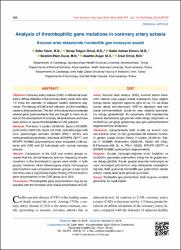Analysis of thrombophilic gene mutations in coronary artery ectasia

View/
Access
info:eu-repo/semantics/openAccessDate
2020Author
Yalım, ZaferTutgun Onrat, Serap
Emren, Sadık Volkan
Dural, İbrahim Etem
Avşar, Alaettin
Onrat, Ersel
Metadata
Show full item recordAbstract
Objective: Coronary artery ectasia (CAE) is defined as localized or diffuse dilatation in the coronary artery lumen of at least 1.5 times the diameter of adjacent healthy reference segments. The etiology of CAE is still unknown, but the most likely cause is atherosclerosis. The aim of this study was to evaluate several gene polymorphisms that are thought to have an effect on the development of coronary atherosclerosis and have been shown to cause thrombophilia in CAE patients. Methods: The factor V Leiden (G1691A), factor V H1299R, prothrombin G20210A, factor XIII V34L, beta-fibrinogen-455 G>A, plasminogen activator inhibitor (PAI)-1 4G/5G, and methylenetetrahydrofolate reductase (MTHFR) C677T, and MTHFR A1298C polymorphisms were evaluated in 66 patients with CAE and 32 individuals with normal coronary arteries. Results: Comparison of the CAE and control groups revealed that the clinical features and the frequency of polymorphism in the thrombophilic genes were similar in both groups. However, when heterozygous and/or homozygous polymorphism was compared between groups, it was found that there was a significantly higher finding of thrombophilic gene polymorphism in the CAE group (p=0.023). Conclusion: Thrombophilic gene polymorphism may be associated with the formation and clinical presentation of CAE. Amaç: Koroner arter ektazisi (KAE), koroner arterin lümeninin lokalize veya yaygın olarak dilatasyonu olup, sağlıklı komşu damar segment çapınına göre en az 1.5 kat dilate olması olarak tanımlanmıştır. KAE’nin etiyolojisi hala tam olarak bilinmemektedir, ancak en olası nedenin ateroskleroz olduğu gösterilmiştir. Bu çalışmada, KAE hastalarında koroner ateroskleroz gelişiminde etkili olduğu düşünülen ve trombofiliye yol açtığı gösterilmiş bazı gen polimorfizmlerini değerlendirmeyi amaçladık. Yöntemler: Çalışmamızda KAE (n=66) ve kontrol (normal koroner arter) (n=32) grubundaki 98 hastada trombofili genleri olarak bilinen Faktör V Leiden (G1691A), Faktör V H1299R, Protrombin G20210A, Faktör XIII V34L, B-Fibrinojen-455 G> A, PAI-1 4G/5G, MTHFR C677T ve MTHFR A1298C polimorfizmi değerlendirildi. Bulgular: Gruplar karşılaştırıldığında klinik özellikleri ve trombofilik genlerdeki polimorfizm sıklığı her iki grupta benzer olduğu görüldü. Ancak, gruplar arasında heterozigot ve/ veya homozigot polimorfizmi olup olmayanlar karşılaştırıldığında, KAE grubunda trombofilik gen polimorfizm olanlar anlamlı olarak daha fazla görüldü (p=0.023). Sonuç: Trombofilik gen polimorfizmi, KAE oluşumu ve klinik görünümü ile ilişkili olabilir.
Source
Türk Kardiyoloji Derneği ArşiviVolume
48Issue
4URI
https://doi.org/10.5543/tkda.2019.99789https://app.trdizin.gov.tr/makale/TXpnd01UYzRPQT09
https://hdl.handle.net/20.500.12933/435















